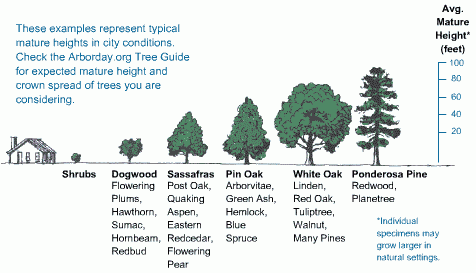Now that spring has finally arrived, we’ve been able to get outside and start making plans for landscaping and gardens this year. And as we prepare to celebrate Arbor Day Friday, some of you may be planning to plant some new trees.
Remember to keep your foundation and house safe as you decide which trees and plants to buy and where to place them.
“Trees have very specific site requirements that should be considered before they are given a new home,” John Lang writes for the Arbor Day Foundation in Nebraska City.
The type of soil in your yard, amount of sunshine available, and our Nebraska weather are important factors in selecting landscaping. Another key factor is how your yard drains after it rains or snows.
“If your yard is sloped, trees and plants at the bottom of your yard will retain more water and may even be prone to drainage issues. Keep this in mind when deciding on the water needs of your future tree,” Lang says.
Growing space also must be considered: how your house is located on your lot, other structures such as decks and sheds, utility lines above and below the ground, and other plants and trees.
“Poor placement can result in roots or branches too close to structures, driveways or sidewalks,” Lang says. Invasive tree roots can cause to foundation cracks, which may lead to leaks and other foundation damage in the future.
“You could also run into problems with underground plumbing, or overhead or underground power lines,” he adds.
 The Arbor Day Foundation offers a sizing guide that shows the growth heights for certain trees.
The Arbor Day Foundation offers a sizing guide that shows the growth heights for certain trees.
If you’re a planting tree to create shade for your house and lower energy bills, position it so it will block the late afternoon sun, according to Jim at YourGardenSanctuary.com. Since afternoon sun shines at a lower angle, “In order to get the most useful shade on a house, you should place a shade tree about 20 feet from the house,” Jim says.
If you plant a tree too close to your house, three big problems can arise:
- Roots can put pressure on the foundation, which can cause mechanical damage.
- Soil moisture can fluctuate, causing soil to contract and expand, which puts pressure on the foundation.
- You can create hazards, such as branches falling on the house.
Roots for some trees grow so aggressively that they shouldn’t be planted even 20 feet or more from your home, Jim writes. They include:
- Cottonwoods and Aspens: They are one of the worst to plant near homes. The wide-spreading root systems of these trees seek out water wherever they can.
- American Elm (Ulmus americana): This tree’s deep roots often clog sewer lines and drains.
- Willows (Salix spp.): Willow roots grow deep and will invade your water systems, septic systems and foundation.
- Norway Maple (Acer platanoides): Because their roots are near the surface, these trees are notorious for lifting and shifting concrete.
Houselogic.com lists other trees that shouldn’t be planted near a house:
- Silver Maple (Acer saccharinum): Shallow and dense roots can grow into foundations, and crack driveways and sidewalks. The trees grow so fast that their wood is weak and brittle, so trees and branches break more easily during severe storms.
- Lombardi Poplar (P. nigra ‘Italia’): These trees are popular because they grow so quickly. “However, they’re prone to a number of diseases and bugs that turn them into raggedy eyesores, and their running roots are invasive and difficult to eradicate.”
- Leland cypress (Cupressocyparis leylandii): Homeowners like to plant these trees to create a “living privacy screen.” However, “the center of the tree forms a mass of dried twigs and branches that are considered such a fire hazard that many communities officially caution residents against planting them.”
Planting things right next your house to hide your foundation is also a bad idea, adds Mike McGrath at Gardens Alive!
“You should always leave a foot of open space around the foundation to prevent moisture buildup that can lead to mold and damaging dampness (and to avoid giving insects like carpenter ants and termites direct access to your home),” McGrath says. “Distance is good for the health of the house — and the plants.”
His rule of thumb for next-to-foundation plantings is this: “Take half of a plant’s ‘final width’ and add a foot; that’s close to a perfect rule for most plants.”
If you have questions or concerns about how planting trees and shrubs could affect your foundation, please call BDB Waterproofing at 402-779-3165 or contact us online.


